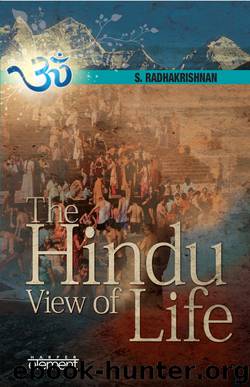The Hindu View of Life by S. Radhakrishnan

Author:S. Radhakrishnan
Language: eng
Format: epub
ISBN: 978-9-3513-6045-2
Publisher: HarperCollins Publishers India
Published: 2009-11-14T16:00:00+00:00
CHAPTER IV
HINDU DHARMA: II
The institution of caste illustrates the spirit of comprehensive synthesis characteristic of the Hindu mind with its faith in the collaboration of races and the cooperation of cultures. Paradoxical as it may seem, the system of caste is the outcome of tolerance and trust. Though it has now degenerated into an instrument of oppression and intolerance, though it tends to perpetuate inequality and develop the spirit of exclusiveness, these unfortunate effects are not the central motives of the system. If the progressive thinkers of India had the power, as they undoubtedly have the authority, they would transform the institution out of recognition. It is not the evils of the system that I am here concerned with so much as the underlying principles.
Any survey of the castes of the present day will reveal the complex origin of the institution. Castes are of many kinds, tribal, racial, sectarian, occupational. Some are due to migration. When members of an old caste migrate to a different part of the country, they become a new caste.
As it is clear from the Sanskrit word varṇa, caste had originally reference to colour. If we look into the past history of India, we see how the country has been subjected to one race invasion after another. Even at the beginning of her history India was peopled by various racial groups, the dark aboriginal tribes, the sturdy Dravidians, the yellow-skinned Mongols and the blithe, forceful Aryans. Very soon she developed intimate intercourse with the Persians, the Greeks and the Scythians, and some of these settled down in India. No other country in the world has had such racial problems as India.
Regarding the solution of the problem of racial conflicts the different alternatives which present themselves are those of extermination, subordination, identification or harmonization. The first course has been adopted often in the course of the history of the world. The trail of man is dotted with the graves of countless communities which reached an untimely end. But is there any justification for this violation of human life? Have we any idea of what the world loses when one racial culture is extinguished? It is true that the Red Indians have not made, to all appearance, any contribution to the world’s progress, but have we any clear understanding of their undeveloped possibilities which, in God’s good time, might have come to fruition? Do we know so much of ourselves and the world and God’s purpose as to believe that our civilization, our institutions and our customs are so immeasurably superior to those of others, not only what others actually possess but what exists in them potentially? We cannot measure beforehand the possibilities of a race. Civilizations are not made in a day, and had the fates been kindlier and we less arrogant in our ignorance, the world, I dare say, would have been richer for the contributions of the Red Indians. Our civilization is quite recent when compared with the antiquity of man and the differentiation of human types.
Download
This site does not store any files on its server. We only index and link to content provided by other sites. Please contact the content providers to delete copyright contents if any and email us, we'll remove relevant links or contents immediately.
| Chakras | Gandhi |
| History | Rituals & Practice |
| Sacred Writings | Sutras |
| Theology |
Fingersmith by Sarah Waters(2483)
Kundalini by Gopi Krishna(2136)
Wheels of Life by Anodea Judith(2096)
Indian Mythology by Devdutt Pattanaik(1898)
The Bhagavad Gita by Bibek Debroy(1897)
The Yoga of Jesus: Understanding the Hidden Teachings of the Gospels by Paramahansa Yogananda(1803)
Autobiography of a Yogi (Complete Edition) by Yogananda Paramahansa(1774)
The Man from the Egg by Sudha Murty(1743)
The Book of Secrets: 112 Meditations to Discover the Mystery Within by Osho(1628)
Chakra Mantra Magick by Kadmon Baal(1616)
The Sparsholt Affair by Alan Hollinghurst(1545)
Sparks of Divinity by B. K. S. Iyengar(1491)
Gandhi by Ramachandra Guha(1486)
Avatar of Night by Tal Brooke(1484)
Karma-Yoga and Bhakti-Yoga by Swami Vivekananda(1467)
The Bhagavad Gita (Classics of Indian Spirituality) by Eknath Easwaran(1452)
The Spiritual Teaching of Ramana Maharshi by Ramana Maharshi(1401)
Hinduism: A Very Short Introduction (Very Short Introductions) by Knott Kim(1344)
Skanda Purana (Great Epics of India: Puranas Book 13) by Bibek Debroy & Dipavali Debroy(1338)
